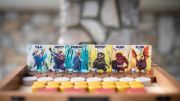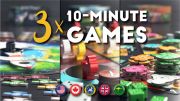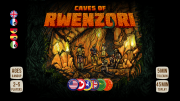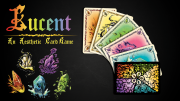Good Puppers (Asmadi Games) – Players are collecting yards full of adorable pups. Every round you take a puppy card and then place it in your yard area. Each puppy has an ability that activates when you play it and the more puppies you have in your yard of the same type, the more effective those abilities become. For instance, the Labrador puppy buries a bone for each Labrador puppy card in your yard. Additionally, some abilities rotate bone cards that are already in your yard, making each card worth more points at the end of the game the more times it is rotated. Each puppy type also has a unique special ability that activates at the end of the game. After each player has played a puppy, everyone chooses a new card for their hand from the marketplace in the center of the table, with the player who played the pup card with the highest number going first. The goal of the game is to have the most points through bones in your yard by the end of the game.
Casual Games on Kickstarter: Good Puppers and Woodland Warfare

While everything else may be uncertain, Kickstarter continues to host great casual games to delight, distract, and entertain — from some of the most adorable puppy artwork you will ever see and light ten-minute card games to strategic word games and tile laying cave escapes.
Storm the Gate: Woodland Warfare (Antsy Labs) – In this dexterity game, you play with a board that has a wall in the center with a small opening in the middle, and walls around both sides of the board so that tokens cannot easily slide off. There is also a bungee cord on either side, strung across the board. The goal of the game is to clear your side of all tokens. During a round, players use the bungee cords to try and shoot tokens through to the other side of the board. Most tokens must go through the gate, but some tokens which represent aerial units, must go over the central wall. Players act simultaneously and as quickly as possible, but you may only shoot one token at a time with your cord. The first player to clear their side wins the round, and the first player to win two rounds, wins the game. (If you are familiar with Fastrack, this game is similar but with a theme and varying disc requirements.)
GPS, Sequoia, and Mountain Goats (BoardGameTables.com) – Three ten-minute games, which you can back separately at $15 each, or get altogether for $39. In Mountain Goat, there are six different mountains and you have a goat meeple at the bottom of each one. On your turn you roll four dice, group them so that each group adds up to at least five, and then use each group to move one space up a mountain based on the mountain and a dice group's number matching. When you reach the top of a mountain you earn a point token and move your goat back to the start of that mountain, but also force all other goats currently climbing it to start at the beginning as well. In Sequoia, everyone rolls five dice at the same time. You then make two sets of two dice (discarding the fifth). For each pair of your dice, you add the two numbers together which tells you which tile to place one of your tree tokens on. After ten rounds, each tile will be rewarded to the players with the most tokens on it. In GPS, each player has twelve satellite tokens, numbered one through twelve. When the game starts, you flip three face up. The board is a spinner. Each turn you spin the spinner and then each player chooses one of their face up tokens and places it at the edge of the board where the spinner stopped. They then flip over another one of their satellites. Once you have placed all your satellites, you move one of your previous satellites instead of placing a new one. The goal of the game is to place your satellites around the board in sequential order.
Kiitos (Matthew Thredgold) – The first player chooses a card from his hand and plays it, announcing a word that starts with that letter. This is the target word. The next player then must play the next letter in that word if they have it, however if they do not have the next letter, they may change the word the players are spelling by playing any letter card and announcing a word that could be spelled with the letters on the table in the order they were played. This is the new target word. Play continues in this manner until a target word is completed, in which case the player who set the target word collects all the cards in that word and places them face up in front of himself (these will be worth points at the end of the game). If, however, it comes to a point where a player cannot continue adding to the target word nor has a card they can play that would allow them to set a new legal target word based on the letters already on the table, then that player gathers up all the cards on the table and places them face down in front of himself (these will be worth negative points at the end of the round). The player with the most points at the end of three rounds wins the game.
Caves of Rwenzori (Vivid Games) – The goal of the game is to lay all your tiles and then play the escape tile to get your meeple out of the cave. On your turn you have three options. Lay a cave tile, move through the cave, or go in blind. When laying a tile, you can lay a normal cave tile adjacent to the tile your meeple is on (assuming the path makes a legal connection), and you then move your meeple onto that tile. However, you can also play obstacle tiles, facedown, adjacent to an opponent's mepele, or dead ends face up adjacent to them, blocking paths. Certain tiles have icons on them, indicating that they are save tiles and can be used to get across obstacle tiles. You can also discard a tile with a light icon on it to flip a face-down tile. However, some tiles have negative effects when flipped over with light. When moving through the cave, you can move through multiple tiles but will not be able to lay a cave tile that turn and must stop at the first empty path where tiles can be laid or the first face-down obstacle tile. Going in blind means you move onto a face-down tile, flip it, and may play the necessary save tile if you have it and move to it, otherwise you will receive a penalty such as adding to your tile deck and will end your turn on the obstacle tile.
Kodama Forest (Indie Boards and Cards) – The newest game in the Kodamaverse, in Kodama Forest you have a forest board between you and the player on your left and another between you and the player on your right. Neighboring players work together to fill the forest board between them by placing forest tiles to cover up the grid featured on the board. Players can combine tiles to complete certain forest features (such as flowers or bamboo) which will in turn cause animal tiles to be added to the board. Some squares on the grids are numbered 5 and 10. The game ends once one of the boards on the table has all the 5 and 10 spaces covered. Each player then scores points for any squares not covered on the boards to the left and right of them, and the player with the lowest score wins the game.
Lucent (Jonah Kellman) – Lucent is a very light card game that is designed to be played in 5-10 minutes. The deck is made up of five different colored gem cards. Each player is dealt a hand of nine cards at the start of the game. Players take turns by playing cards into a pyramid. You may add any colored card to the bottom row (which can only hold a certain number of cards), but when adding a card to higher rows, it must match one of the two gems in the row below it. If you are not able to play a card on your turn, you are out of the game. The last player to stay is the winner.
Disclosure: unless otherwise noted, we have not seen or played any of the above games. Our assessment of each is based on the information given on the crowdfunding project page.











